Znamianka
Зна́м'янка | |
|---|---|
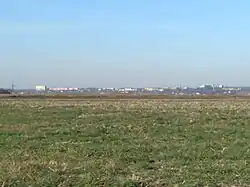 view from the south (2021) | |
 Flag  Coat of arms | |
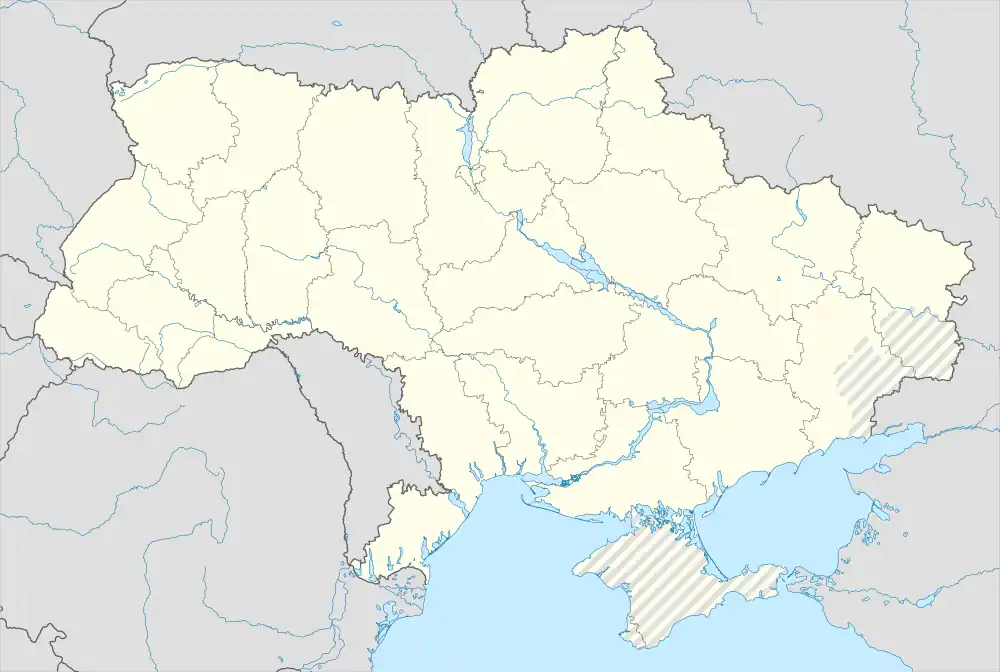 Znamianka 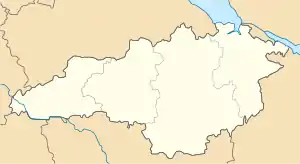 Znamianka | |
| Coordinates: 48°42′49″N 32°40′24″E / 48.71361°N 32.67333°E | |
| Country | |
| Oblast | |
| Raion | |
| Founded | 1869 |
| Area | |
| • Total | 14.8 km2 (5.7 sq mi) |
| Population (2022) | |
| • Total | 21,221 |
| • Density | 1,400/km2 (3,700/sq mi) |
| Postal code | 27400 |
| Area code | +380 5233 |
Znamianka (Ukrainian: Зна́м'янка) is a city in central Ukraine, Kropyvnytskyi Raion, Kirovohrad Oblast. It hosts the administration of Znamianka urban hromada, one of the hromadas of Ukraine.[1] Population: 21,221 (2022 estimate).[2]
It is located about half way between the regional center Kropyvnytskyi (west), and cities of Oleksandriia (east) and Svitlovodsk (north).
History
The lands of the modern Kirovohrad region and the Znamianka territorial hromada were first inhabited by Scythians, it was near the Znamyanka that a bronze and golden image of the Scythian eagle was found, which is now a symbol of the region. In the Middle Ages, during the time of Kyivan Rus', the East Slavic tribe of Ulichis lived here.
After the liberation of the former Kyivan Rus' from the Tatars in the Battle of Blue Waters and the unification of the principalities of Kyiv, Pereyaslav, and Chernihiv with the Grand Duchy of Lithuania, there was a need to protect the southeastern borders from attacks by the Crimean Khanate and Moscovy - states that were formed after the collapse of the Golden Horde at the end of the 15th century . For this , Dmytro Vyshnevetsky founded the first Zaporozhian Sich on the island of Khortytsia, thus the Ukrainian Cossacs appeared. On the territory of the modern Kirovohrad region the Zaporozhians founded many villages near the territory of modern Znamianka , like Moshoryne and Subottsi. After the destruction of the Zaporizhzhya Cossacks by the Russians in 1775, the lands of central Ukraine came under the direct authority of Russian Empire

Znamianka was established in 1869 when there started train movement between Kharkiv and Odesa in area that historically was known as Black Forest (or Nigra Sylva).[3] At the meadow of Black Forest, through which stretched a segment of Yelizavetgrad – Kriukov (west–east), there was built the train station main building and its offices.[3] The station was named after the original village Znamianka that was located 3 km (1.9 mi) away[3] and today is known as Znamianka Druha.
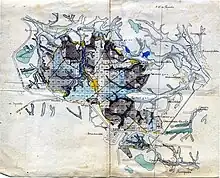
To the area were resettled peasants from the Oryol Governorate area, possible the Russian Old Believers for whom the Our Lady of the Sign sacred. In Russian the Sign means Znamiennie, so in diminutive form the settlement's name became Znamianka.
In 1873 there was opened movement of trains on the segment Znamianka – Mykolaiv, in 1876 towards Fastiv.[3] Out of a small train station Znamianka started to transform into a rail hub.[3] Znamianka became a train station at four-way crossroads northeast towards Kremenchuk, south towards Mykolaiv, west towards Balta and northwest towards Fastiv. Simultaneously with building of the train station on a land lot that was rent out from landowners Osipovs by people from neighboring villages and other counties (uyezds), there appeared a small settlement of railway workers, Osipovoye.[3]

In 1886 there already were 24 private houses, an earth shelter, six trading places and population of 143.[3] Couple of dozens years later just south of the train station there appeared another settlement of Linitskoye.[3]

In 1913 in both Osipovoye and Linitskoye lived about 6,000 people.[3] In the beginning for sometime the train station was classified of the third category with its locomotive depot accounting for 4 locomotives.[3] In December 1883 when there ended construction of the new train station building, there were 29 locomotives and the depot employed some 92 workers.[3] In the 1890s the rail hub was shipping out some 580,000 poods of bread annually.[3]
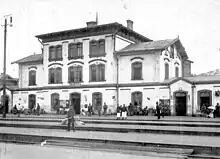
During the 1917 to 1921 Ukrainian War of Independence and Ukrainian-Soviet war Znamianka was part of Ukrainian People's Republic , Ukrainian state , and the Kholodny Yar Republic. In 1920 Znamianka was captured by the Soviet army for the third time .[4] In 1923 Znamianka became the district center, which was subordinated to 9 village councils. In 1930, Znamianka received the status of an urban-type settlement.

During the Holodomor (1932-1933) and Soviet repressions , at least 891 residents died . According to eyewitnesses, in 1933, in the area of the old railway station, exhausted peasants who escaped from the collective farms and tried to leave for the cities fell out of the freight cars. They were hidden by equally hungry local residents near the station itself or on its outskirts. In 1938, Znamianka received the status of a city , with a population of 14,600 people.
During World War II Znamianka was under German occupation from August 5, 1941 to December 9, 1943. The Nazis shot 753 civilians, tortured 188 people, and forcibly transported 1,121 people to hard labor in Germany.

After the World War II , a new railway station was built in 1952, and five-story residential buildings in the 1960s. In 1977, the City Palace of Culture was opened. And in the 1980s, nine-story residential buildings were built . In January 1989 the population was 33 828 people.[5]
In 2012, based on the law "On the principles of the State language policy", City Council declared Znamianka's regional language to be Russian.[4] On 28 February 2018 the Constitutional Court of Ukraine ruled this law unconstitutional.[6]
In January 2013 the population was 23 983 people.[7]
During the period of Anti-Terrorist Operation in the East of Ukraine (2014-2018) and the Operation of the United Forces (2018-2021), almost 1,000 citizens of Znamianka took part in combat operations. 12 died, a central street in the city was named after one of them (Victor Holyi)

Until 18 July 2020, Znamianka was designated as a city of oblast significance and belonged to Znamianka Municipality but not to Znamianka Raion even though it was the center of the raion. Znamianka Municipality combined the city of Znamianka, the urban-tye settlement of Znamianka Druha, and the 4 villages : Petrove , Vodiane , Sokilnyky and Novooleksandrivka . As part of the administrative reform of Ukraine, which reduced the number of raions of Kirovohrad Oblast to four, Znamianka Municipality was merged into Kropyvnytskyi Raion.[8][9]

During the Russian invasion of Ukraine, Znamianka became a refuge for several thousand refugees from the southeast of the state
Galery







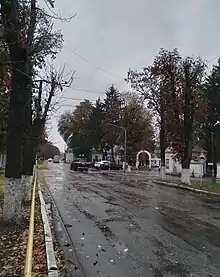
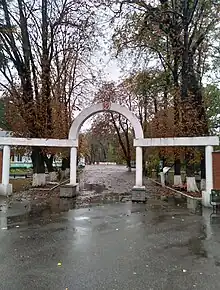


Geography
Climate
| Climate data for Znamianka (1981–2010) | |||||||||||||
|---|---|---|---|---|---|---|---|---|---|---|---|---|---|
| Month | Jan | Feb | Mar | Apr | May | Jun | Jul | Aug | Sep | Oct | Nov | Dec | Year |
| Mean daily maximum °C (°F) | −1.4 (29.5) |
−0.5 (31.1) |
5.0 (41.0) |
14.5 (58.1) |
21.3 (70.3) |
24.5 (76.1) |
26.9 (80.4) |
26.6 (79.9) |
20.5 (68.9) |
13.1 (55.6) |
4.7 (40.5) |
−0.1 (31.8) |
12.9 (55.2) |
| Daily mean °C (°F) | −4.0 (24.8) |
−3.6 (25.5) |
1.3 (34.3) |
9.0 (48.2) |
15.2 (59.4) |
18.6 (65.5) |
20.8 (69.4) |
20.1 (68.2) |
14.5 (58.1) |
8.2 (46.8) |
1.7 (35.1) |
−2.6 (27.3) |
8.3 (46.9) |
| Mean daily minimum °C (°F) | −6.7 (19.9) |
−6.5 (20.3) |
−2.1 (28.2) |
4.1 (39.4) |
9.3 (48.7) |
13.3 (55.9) |
15.2 (59.4) |
14.3 (57.7) |
9.5 (49.1) |
4.2 (39.6) |
−1.0 (30.2) |
−5.1 (22.8) |
4.0 (39.2) |
| Average precipitation mm (inches) | 35.8 (1.41) |
34.0 (1.34) |
34.3 (1.35) |
36.9 (1.45) |
50.3 (1.98) |
81.6 (3.21) |
72.1 (2.84) |
53.0 (2.09) |
57.9 (2.28) |
42.0 (1.65) |
41.7 (1.64) |
36.8 (1.45) |
576.4 (22.69) |
| Average precipitation days (≥ 1.0 mm) | 7.3 | 7.1 | 7.7 | 6.9 | 7.1 | 8.9 | 7.1 | 5.5 | 6.3 | 5.4 | 7.1 | 7.2 | 83.6 |
| Average relative humidity (%) | 86.6 | 83.7 | 79.0 | 68.3 | 64.5 | 69.4 | 68.3 | 65.6 | 72.6 | 79.7 | 87.4 | 88.3 | 76.1 |
| Mean monthly sunshine hours | 52.9 | 76.5 | 134.2 | 186.3 | 283.8 | 289.5 | 312.9 | 294.0 | 211.1 | 141.4 | 57.7 | 44.0 | 2,084.3 |
| Source: World Meteorological Organization[10] | |||||||||||||
References
- ↑ "Знаменская городская громада" (in Russian). Портал об'єднаних громад України.
- ↑ Чисельність наявного населення України на 1 січня 2022 [Number of Present Population of Ukraine, as of January 1, 2022] (PDF) (in Ukrainian and English). Kyiv: State Statistics Service of Ukraine. Archived (PDF) from the original on 4 July 2022.
- 1 2 3 4 5 6 7 8 9 10 11 12 (Знам’янка, Знам’янський район, Кіровоградська область). The History of Cities and Villages of the Ukrainian SSR (ukrssr.com.ua).
- 1 2 (in Ukrainian) Without favorites and self-nominated. Who claims to win the "hot spot" of the elections in Kirovograd region, The Ukrainian Week (14 October 2020)
- ↑ Всесоюзная перепись населения 1989 г. Численность городского населения союзных республик, их территориальных единиц, городских поселений и городских районов по полу
- ↑ "Constitutional Court declares unconstitutional language law of Kivalov-Kolesnichenko". Ukrinform. 28 February 2018. Retrieved 2019-05-04.
- ↑ Чисельність наявного населення України на 1 січня 2013 року. Державна служба статистики України. Київ, 2013. стор.70
- ↑ "Про утворення та ліквідацію районів. Постанова Верховної Ради України № 807-ІХ". Голос України (in Ukrainian). 2020-07-18. Retrieved 2020-10-03.
- ↑ "Нові райони: карти + склад" (in Ukrainian). Міністерство розвитку громад та територій України.
- ↑ "World Meteorological Organization Climate Normals for 1981–2010". World Meteorological Organization. Archived from the original on 17 July 2021. Retrieved 17 July 2021.
External links
- Volodymyr Panchenko. In the arms of the Black Forest (В обіймах Чорного лісу). The Ukrainian Week. 29 October 2017